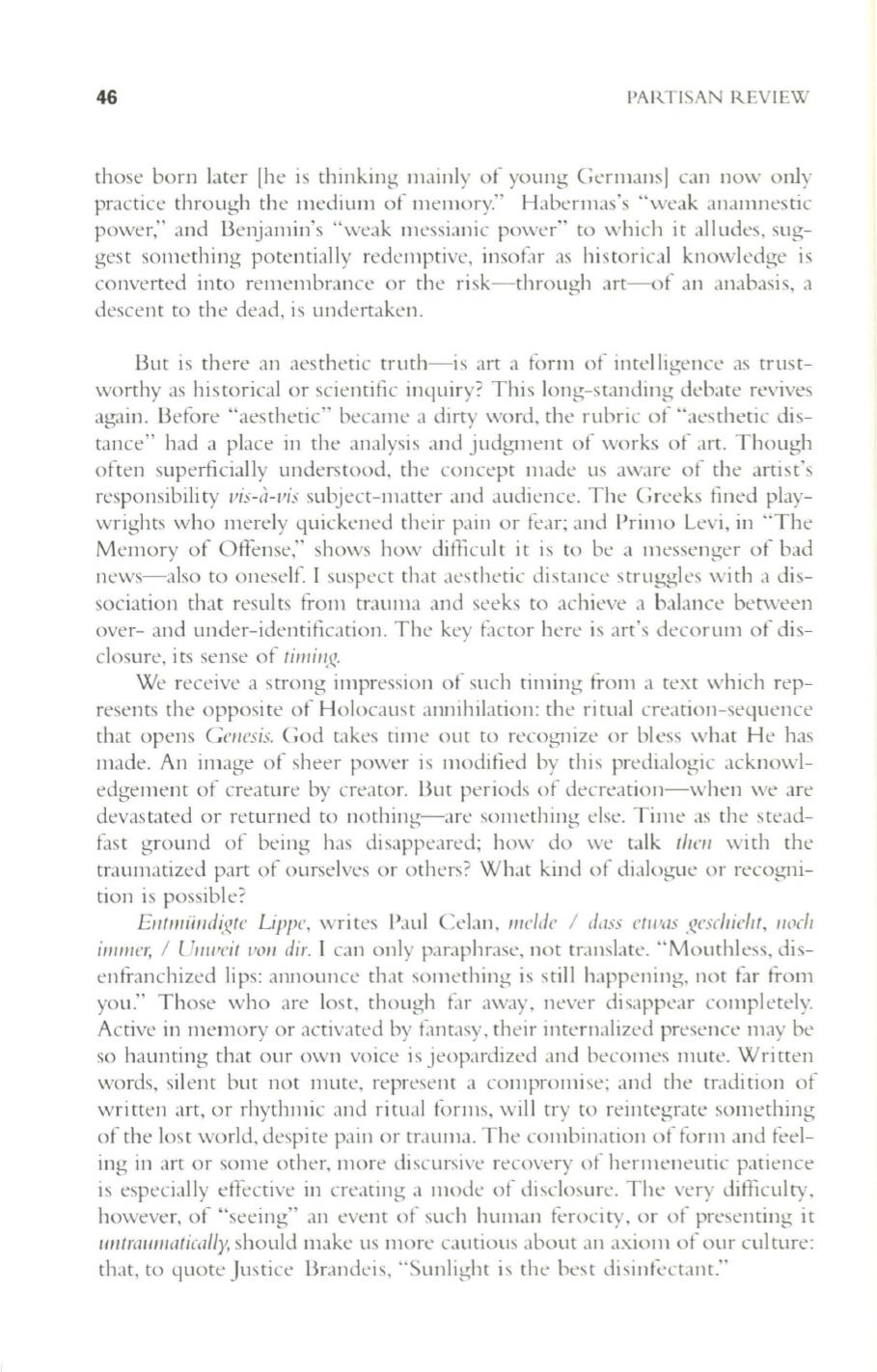
46
PART ISAN REV I EW
those bo rn later [he is thinkin g mainl y of young Ge rmansi can now only
practi ce through th e medium of memo ry." Habermas's "weak anamn es ti c
power," and Benj amin's "weak mess iani c power" to w hi ch it all udes, sug–
ges t somethin g potentiall y redempti ve, inso f:lI" as histori cal kn owledge is
converted into remembrance o r the ri sk- through art-of an anabasis, a
descent to th e dead, is undertaken .
But is there an aes theti c tr uth- is art a fo rm of intelli gence as trust–
wo rthy as hi stori cal or scientifi c inquiry? Thi s long-s tanding debate revives
again . Before "aes theti c" became a dirty word , the ru bri c of "aes th eti c di s–
tance" had a place in the analys is and judgment of wo rks of art. Though
often superfi cially unders tood, the concept made us aware o f the arti st's
responsibility
vis-a- /Jis
subj ect- matter and audi ence. Th e Greeks fin ed play–
wri ghts who merely quickened their pain o r fea r; and PrinlO Lev i, in "The
Memo ry o f O ffen se," shows how diffi cult it is to be a messenger of bad
news-also to oneself. I suspec t that aes th eti c di stance struggles with a di s–
sociati on that results from trauma and seeks to ac hi eve a balance between
over- and under-identifi ca ti o n. Th e key factor here is art's decor um of di s–
closure, its se nse o f
lilllillK
We receive a strong impress ion of such timing fr om a text whi ch rep–
resents the opposite of Holocaust annihilati on: the r itual creatio n-sequence
that opens
GCIIesis.
God takes time o ut
to
recogni ze or bl ess what He has
made. An image of shee r power is modifi ed by thi s predialogic ac knowl–
edgement o f crea ture by crea to r. But peri ods of decn:ati o n- when we are
devas tated o r returned to no thing-are something else. Time as th e stead–
fas t ground of bein g has di sappea red; how do we talk
111m
with the
traumati zed part of ourselves o r o th ers? What kind of di alogue o r recogni–
ti on is possibl e?
E lllllliilldl:elC Lippc,
writes Paul Celan ,
11I('lIlc / rillSS CII I'IlS gesellicll
I,
1I0cil
illIlIl Cr, / U II ll'eil VOII dir.
I can only pa raphrase, no t translate. " Mouthl ess, dis–
enfranchi zed lips: anJ1 0un ce that something is still happenin g, no t fa r from
you ." T hose who are los t, th ough
Ell·
away, never di sappea r compl etel y.
Acti ve in memory o r acti va ted by f:mtasy, th eir illtern ;lli zed presence may be
so haunting that our own vo ice is j eopardi zed and becomes mute. Written
wo rds, silent but no t mute, represent a compromi se; and the traditi on o f
wri tten art, o r rhythmi c and ri tu al fo rms, will try to reintegrate something
of the los t world , despite pain or trauma. T he combinati on of fo rm and feel–
ing in art o r some o ther, mo re d iscursive recovery of herm eneuti c pati ence
is especially effective in crea tin g a mode of di sclosure. T he ve ry d iffi cul ty,
however, of "seein g" an event of such human fe roc ity, o r of presenting it
IIl1lrn lllllllliw /l y,
shoul d make us mo re cauti ous about an ax iOIll of our cui ture:
that, to quo te Justi ce Brande is, "Sunli ght is the best di sinfectant."


